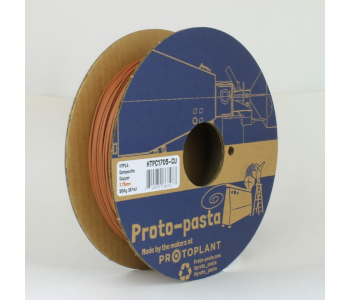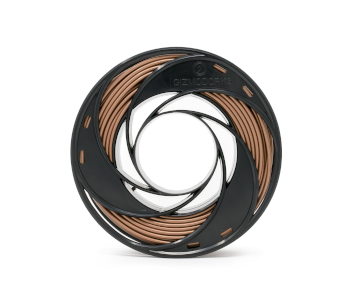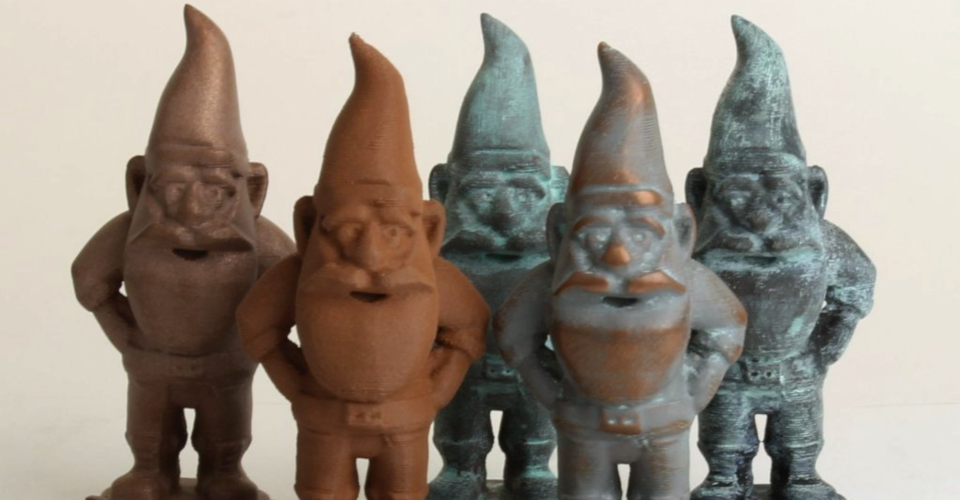3D Printing with Copper Filament: Properties and Settings
Copper has long been valued for its visual appeal. The various uses of copper in architectural design is a testament to that. From gutters to counter tops, the characteristic greenish-brown patina of copper gives it a distinct look that has kept it relevant centuries after it was first discovered.
Working with copper takes exceptional skill, but did you know that you can produce objects with a copper-like finish using just a 3D printer? Copper filament has proven to be one of the most popular and best-selling of the metal-filled filaments, mostly because of how good it makes finished print looks. What exactly is copper filament made of and how is it best used?
What is copper filament?
Copper filament is one example of a metal-filled filament along with brass, bronze, and stainless steel. The filament is basically made of a mixture of copper in metal powder suspended in a PLA matrix. The use of PLA as the plastic matrix helps make copper filament an easy material to work with. The ratio of copper to PLA may vary across different brands and this ratio has palpable effects on the filament’s price, printing performance, and quality of output.
Again, it is important to note the difference between copper filament that is metal-filled and those that are copper-colored. Metal-filled filament is much more expensive and is a bit harder to print with but will give you more genuine-looking copper prints. Copper-colored filaments are the cheaper option but probably won’t help you convince that many people that you worked with real copper. It’s your call if you choose to pick a copper-colored filament, but we’re focusing on metal-filled ones in this article.
Pros and cons of copper filament
If this is your first time making the switch from a pure plastic filament to a composite one, then there are a couple of precautions to watch out for and challenges to anticipate. That’s not meant to paint a bleak picture of working with copper filaments – the results are well worth the extra effort and price.
PROS
1. Unique visual appeal
There’s nothing quite like a high-quality print made with copper filament. If you’ve been inspired by classic architectural design or the gorgeous green patina of the Statue of Liberty, then printing with a copper filament is a great way to boost your creativity and get you excited about 3D printing again. The dark brown color of copper would look great on custom display pieces that you can place around the house or custom jewelry that you can wear or give as gifts.
2. Looks great when polished
To manage your expectations, let us tell you that a copper print doesn’t look great right out of the printer. The lack of polish and visible layer lines do a great disservice to the potential of the material. It takes a little bit of sanding and polishing to make the color and luster of the embedded copper powder pop out. The exposed copper powder can even be oxidized with some vinegar to allow the development of the characteristic green patina. Simply put, copper filament provides finishing opportunities that would not have been possible with other filaments.
3. Heavier than standard PLA
The usual parts 3D printed with plastic tend to feel cheap because of how light they are. Between the lightweight plastic material and the abundance of void space in most of these prints, passing them off as premium products usually requires an amazing streak of marketing.
Prints made with copper basically sell themselves. Aside from the possibility of a gorgeous finish, a print made with copper filament can weight twice to thrice as much as a similar print made with PLA. This characteristic heft adds a bit of premium quality to copper-filled prints that belies the fact that it was made using the same 3D printer that can be used to print with full plastic.
CONS
1. Expensive
The price of a copper-filled filament will depend on how much copper has actually been infused into the PLA matrix but one thing is sure: it’s much more expensive than standard PLA. The Virtual Foundry sells a copper filament with a composition that is just short of pure copper – 90% copper to 10% PLA. A 1-kilogram spool of this filament costs around $120.
Compare this to a PLA spool that you can buy for less than $15 and it’s immediately obvious that copper filament isn’t something you play around with.
Aside from the price per weight, you’ll also need to keep in mind that the filament is denser than pure plastic. This means that the 1-kilogram spool of copper filament contains much less filament, in terms of length, than the 1-kilogram spool of PLA.
2. Brittle filament
The addition of copper powder into the PLA matrix results in a filament that is much more brittle and rigid than standard PLA. This is great for the finished print, but not so good for the filament. Considering how thin these filaments are, you’ll need to handle them very carefully so they don’t snap. We wouldn’t be surprised if your copper filament snaps in the middle of printing, which could lead to disastrous results if you can’t step in right away. It’s an added complication to the print process that you’ll need to learn to work with.
3. Abrasive material
As with other metal-filled filaments, the presence of copper powder in copper filament makes it more abrasive to the parts of the 3D printer it comes into contact with. Your biggest cause of concern should be your nozzle, especially if you’re using the 0.4-millimeter brass nozzle that usually comes with desktop 3D printers.
If you plan on working with a lot of metal-filled filaments, then you might want to invest in an abrasive-resistant nozzle that is made of stainless steel. Since the solid particles tend to clump together near the nozzle’s orifice, getting a wider nozzle is also a good idea. Consider upgrading to a nozzle with an opening 0.5 to 0.6 mm.
How to print with copper filament
The beauty of printing with copper filament is that the experience isn’t that much different from printing with pure PLA, with just a few exceptions. This means that you won’t need to worry about warping issues, and you won’t even need a heated print bed.
Copper filament prints at 190 to 220 °C. You might notice that this is the same printing temperature range as standard PLA. We recommend starting at the lower end of the range and increasing the temperature as long as you don’t experience any stringing problems.
A heated print bed isn’t necessary when working with copper filament, but you will have to treat your print bed with a layer of glue stick or blue painter’s tape. The ideal setup would still have a heated glass print bed set at 55 to 60 °C. You can print directly on a glass heated print bed with no bed adhesion aid.
The presence of copper powder, a highly conductive metal, in the filament makes it very easy to melt. This allows for relatively rapid printing of copper filament. To start, you can set your printing speed to 30 mm/s and increase it gradually until you see signs of blobs or strings.
The conductive nature of copper means that it will also cool down more rapidly. This creates sturdier prints and means that there’s no point in trying to control the temperature of the build chamber. Keep your cooling fan turned off for the first three layers just to help with bed adhesion, then turn it to maximum setting from thereon. This should help the material develop rigidity faster and keep any overhanging features from collapsing.
The contraction caused by the cooling of copper should be enough to pry it off the print bed automatically. If not, a slight push or lifting it with a spatula should get it off without much difficulty. An unpolished copper print isn’t going to look great, especially since the presence of copper powder will make its surface look rough and uneven.
Fortunately, it doesn’t take much to refine your copper print. A bit of sanding would help even out its surface and expose the copper powder embedded in the plastic matrix. The usual sanding procedure applies here – start with coarse-grit sandpaper and work your way up to finer grit versions. You can apply a metal polish to the surface of the print, but even rubbing the surface with a soft cloth should result in a significant enhancement of your print’s gloss and luster.
One of the more unique finishing techniques you can do with copper takes advantage of its vulnerability to oxidation. By purposely oxidizing the metal with some vinegar, you can induce it to develop the distinct green patina that is a feature of classical copper pieces.
It doesn’t take much for this to happen – just wet a paper towel with some vinegar and dab it on your finished print. The quality of green patina will depend on how much copper your filament has. You can also heat up your prints slightly (around 40 °C) to speed up the oxidation process.
Best brands of copper filament
1. Proto-pasta Composite Copper HTPLA Filament

The Composite Copper HTPLA Filament from Proto-pasta is one of the best options for copper filaments in the market that strike a good balance between performance and ease of use. The HTPLA is a more temperature resistant version of standard PLA, allowing heat treatment of the finished print up to 160 °C.
The Composite Copper Filament is made of 60% copper and 40% PLA. The high copper content creates prints with a unique rustic appearance. Sanding, polishing, and brushing with an oxidizing agent are the best methods for finishing prints made with this filament. Heat treatment, or annealing, is an option for accelerating the oxidation step.
The modification to PLA’s heat resistance via rearranging of the crystalline structure is one of the best characteristics of this filament. It successfully bridges the performance gap of standard PLA and extends the usefulness of the filament’s finished products.
2. Gizmo Dorks Metal Copper Fill Filament

If you’re curious about trying a copper filament but aren’t keen on committing to an expensive 1-kilogram spool, then this 200-gram sampler spool from Gizmo Dorks was made for you. It’s a standard copper and PLA composite filament that doesn’t try really try and revolutionize the product but creates some really visually appealing prints.
Gizmo Dorks doesn’t offer information on how much copper this filament actually contains, but its results and performance seem to indicate a pretty low number. Finished prints are quite resistant to oxidation, so developing that green patina may be a disappointing experience. On the upside, the filament is not too brittle and easy is very easy to work with.
At less than $10, the 200-gram Gizmo Dorks copper filament offers a low-cost introduction to the world of metal-filled filaments. This can be an expensive hobby, so it’s nice to see brands catering to the budget market.
3. Virtual Foundry Copper Filamet
The “Copper Filamet” from Virtual Foundry is in a league of its own. With 90% copper content, the goal of this filament is to create 3D printed projects made completely with copper by using PLA merely as a “vehicle” for the metal.
The idea is to print with the Copper Filamet using a standard FDM printer. Some measures will have to be put in place, such as using a nozzle with a wider orifice and printing at slightly higher temperatures. Upon finishing the print, it is then placed inside a sintering furnace to melt the plastic and leave behind a 100% copper object.
Some shrinkage will be expected because of the loss of plastic material. The finished copper print will effectively be porous and not super durable. However, this is far and away the easiest method of creating something made of pure copper. The copper can also be treated with an oxidizing agent to develop a green patina.
As you would expect, this is probably the most expensive copper filament that you can buy. You are also going to need a furnace – not exactly something that hobbyist 3D printers have at home. This technology is more appropriate for professional users, the production of one-off parts, and rapid prototyping.
The roundup
| Material | Copper filament (copper powder in PLA matrix) |
| Properties | Excellent visual appeal, can be finished by oxidation, brittle and abrasive filament, denser than standard PLA |
| Applications | Custom jewelry and display pieces |
| Printing temperature | 190 to 220 °C |
| Bed temperature | Not needed, but a heated bed at 55 to 60 °C is ideal |
| Bed adhesion | Glue stick or blue painter’s tape on a non-heated bed; no adhesion aid needed for glass heated bed |
| Printing speed | Start at 30 mm/s |
| Cooling? | No cooling on first three layers; cooling at maximum on all succeeding layers |
3D printing with copper-filled filament is a good shortcut to working with actual copper. At a fraction of the skill and effort involved in working with real copper, you can create your very own customized copper display pieces and jewelry. Copper filament (or any composite filament) is a good way to expand your horizons in 3D printing and learn about a few new techniques.


